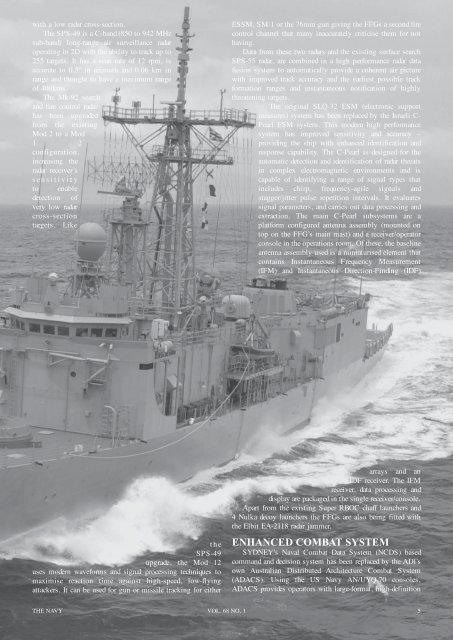The Navy Vol_68_No_1 Jan 2006 - Navy League of Australia
The Navy Vol_68_No_1 Jan 2006 - Navy League of Australia
The Navy Vol_68_No_1 Jan 2006 - Navy League of Australia
You also want an ePaper? Increase the reach of your titles
YUMPU automatically turns print PDFs into web optimized ePapers that Google loves.
with a low radar cross-section.<br />
<strong>The</strong> SPS-49 is a C-band (850 to 942 MHz<br />
sub-band) long-range air surveillance radar<br />
operating in 2D with the ability to track up to<br />
255 targets. It has a scan rate <strong>of</strong> 12 rpm, is<br />
accurate to 0.5º in azimuth and 0.06 km in<br />
range and thought to have a maximum range<br />
<strong>of</strong> 400kms.<br />
<strong>The</strong> Mk-92 search<br />
and fire control radar<br />
has been upgraded<br />
from the existing<br />
Mod 2 to a Mod<br />
1 2<br />
configuration,<br />
increasing the<br />
radar receiver’s<br />
s e n s i t i v i t y<br />
to enable<br />
detection <strong>of</strong><br />
very low radar<br />
cross-section<br />
targets. Like<br />
ESSM, SM-1 or the 76mm gun giving the FFGs a second fire<br />
control channel that many inaccurately criticise them for not<br />
having.<br />
Data from these two radars and the existing surface search<br />
SPS-55 radar, are combined in a high performance radar data<br />
fusion system to automatically provide a coherent air picture<br />
with improved track accuracy and the earliest possible track<br />
formation ranges and instantaneous notification <strong>of</strong> highly<br />
threatening targets.<br />
<strong>The</strong> original SLQ-32 ESM (electronic support<br />
measures) system has been replaced by the Israeli C-<br />
Pearl ESM system. This modern high performance<br />
system has improved sensitivity and accuracy –<br />
providing the ship with enhanced identification and<br />
response capability. <strong>The</strong> C-Pearl is designed for the<br />
automatic detection and identification <strong>of</strong> radar threats<br />
in complex electromagnetic environments and is<br />
capable <strong>of</strong> identifying a range <strong>of</strong> signal types that<br />
includes chirp, frequency-agile signals and<br />
stagger/jitter pulse repetition intervals. It evaluates<br />
signal parameters, and carries out data processing and<br />
extraction. <strong>The</strong> main C-Pearl subsystems are a<br />
platform configured antenna assembly (mounted on<br />
top on the FFG’s main mast) and a receiver/operator<br />
console in the operations room. Of these, the baseline<br />
antenna assembly used is a miniaturised element that<br />
contains Instantaneous Frequency Measurement<br />
(IFM) and Instantaneous Direction-Finding (IDF)<br />
t h e<br />
SPS-49<br />
upgrade, the Mod 12<br />
uses modern waveforms and signal processing techniques to<br />
maximise reaction time against high-speed, low-flying<br />
attackers. It can be used for gun or missile tracking for either<br />
arrays and an<br />
IDF receiver. <strong>The</strong> IFM<br />
receiver, data processing and<br />
display are packaged in the single receiver/console.<br />
Apart from the existing Super RBOC chaff launchers and<br />
4 Nulka decoy launchers the FFGs are also being fitted with<br />
the Elbit EA-2118 radar jammer.<br />
ENHANCED COMBAT SYSTEM<br />
SYDNEY’s Naval Combat Data System (NCDS) based<br />
command and decision system has been replaced by the ADI’s<br />
own <strong>Australia</strong>n Distributed Architecture Combat System<br />
(ADACS). Using the US <strong>Navy</strong> AN/UYQ-70 consoles,<br />
ADACS provides operators with large-format, high-definition<br />
THE NAVY VOL. <strong>68</strong> NO. 1 5

















